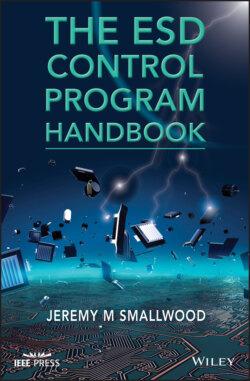Читать книгу The ESD Control Program Handbook - Jeremy M. Smallwood - Страница 13
Foreword
ОглавлениеI was quite flattered when Dr. Jeremy M Smallwood asked me to write this foreword for his book. I view this as a significant honor. Dr. Smallwood (Jeremy) and I have worked together on standards for electrostatics since the mid‐1990s after the IEC formed Technical Committee 101 – Electrostatics. Both of us had considerable time invested in the standards process on our sides of the Atlantic: Jeremy with BSI and myself with the ESD Association (ESDA). In the early 1990s, several things occurred: The IEC formed Technical Committee‐TC101 – Electrostatics. Most of the original members were from the CENELEC committee that produced the electrostatics document CECC00015 along with delegates from other non‐European countries; and the ESDA became a recognized American National Standards (ANSI) development body, thus able to officially represent the United States to the IEC. I was appointed the first lead delegate from the United States National Committee, and Jeremy was appointed delegate from the UK National Committee. I had the pleasure of hosting an early IEC TC101 working group meeting in Austin, Texas, in 1996, following our annual EOS/ESD Symposium held that year in Orlando, Florida. That was the first time I met Jeremy. While the early years of deliberation on standards for electrostatics were contentious at times, the committee eventually came together to form a cohesive group and has prepared important standards, recognized around the world. Jeremy had considerable input and influence during the formative years of TC101, including his long‐term appointment as the TC101 Chairman. Currently, he is the lead delegate from the UK and participates actively on many working groups.
As a past president of the ESDA, I was delighted to present Jeremy with the ESD Association's Industry Pioneer Award in 2010 in recognition of his contribution to the science of electrostatics, and in particular, for his role in standards development.
There are many good books on the fundamentals of electrostatics by well‐known authors and practitioners such as Professor Niels Jonassen, University of Denmark and Professor A.D. Moore (University of Michigan). There are other books that deal with specific issues in electrostatics and these can be found in the Bibliography of this book. However, this is one of the few that covers all the aspects of the modern standardization process for electrostatic control in the manufacturing of electronics and other materials sensitive to electrostatic influences. This book is designed to assist a novice to the world of electrostatics as well as the expert practitioner. I believe the book could be a useful reference to anyone who has to deal with electrostatics in any field and in particular, electronics manufacturing operations. The principles and standards discussed herein may be applied to any manufacturing area and process. This book would also be useful as a text for a college level course dealing with electronic design when the subject matter turns to reliability and sensitivity of electronic parts and assemblies.
Dr. Smallwood uses his considerable experience in standards development and practical experience to guide the reader through the maze and tangle often associated with application of standards to a manufacturing process. Since electrostatics is a natural phenomenon and around us all the time, one would think standardization is an improbable task (maybe leaning toward impossible). The practical approach taken by Jeremy in Chapters 9 and 10 helps sort out the implementation and program management processes.
Chapter 12 on Training should be extremely useful to anyone that has to set‐up, run and maintain an ESD control program. Jeremy has provided some very useful “tips” on training considerations, garnered from his years of experience in providing basic to advanced classes on the “art and science” of electrostatics.
Another important section is Chapter 6 which covers standards very well. Since the early 1990s, the understanding of how to deal with the “mysteries” of electrostatics in industry has increased dramatically, with the result being able to develop very useful and practical standards, standard practices, advisories and operating guides. While we must appreciate and understand that static electricity cannot be prevented, we now know how to live with it in the manufacturing world and generally can provide mitigation techniques to resolve most issues before serious problems occur. That being said, fires and explosions, product damage and loss of life occur every year due to static electricity happening when least expected or when proper procedures are not followed. Simply having a bad connection to ground (earth) in the wrong place at the wrong time can (and does) have catastrophic results more often than most will realize.
The first step in resolving or preventing electrostatic issues is to develop an understanding of the phenomenon. Chapters 1–5 provide an excellent introduction to the basic considerations involved in electrostatics and will be a great starting point for the novice in this subject. Even the experienced practitioner will find these chapters useful for review and provide a reminder of what they have “forgotten.” Overall the book is written for the non‐technical person to be able to understand the electrostatic phenomenon but the “expert” in the field will also find it useful. The extensive bibliography provides a great resource for anyone needing details on any of the related subjects.
I am confident that you will find this book as entertaining, enlightening and useful as I have. Happy reading and stay safe.
David E. Swenson, President, Affinity Static Control Consulting, LLC
deswenson@affinity-esd.com
2609 Quanah Drive, Round Rock, Texas, USA 78681
Past President, ESD Association – 1998, 1999, 2008, and 2009
ESD Association Outstanding Contributions Award, 2002
Joel P. Weidendorf Memorial Award – for contribution to ESDA Standards Development – 2004
Edward G. Weggeland Memorial Award – for contributions to the operation of the ESD Association – 2014
